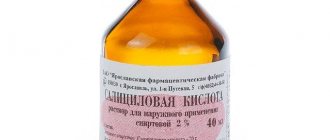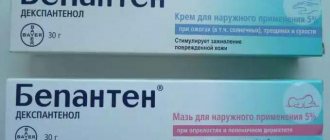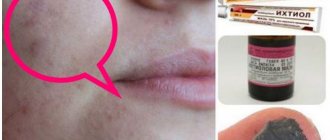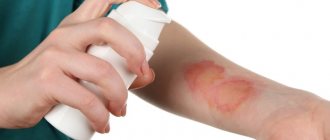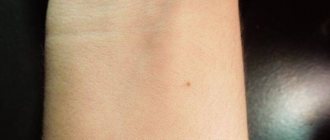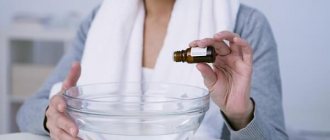Pimples can occur anywhere, but they are especially troublesome on the face and lips. The rashes cause discomfort, can fester, and, therefore, the infection on the face will spread.
Photo 1 - Pimples on the lips cause discomfort
When they appear on the lips, they can cause severe pain and interfere with eating and kissing. It is difficult for men to shave this area clean and sometimes even difficult to speak. Before treating a pimple, it is necessary to determine what caused it and what the nature of its occurrence is.
Photo 2 - Pimples on the lips in men
Causes:
- herpes;
Photo 3 - Example of herpes
- acne vulgaris;
Photo 4 - Example of acne vulgaris
- stomatitis;
Photo 5 - Example of stomatitis
- infection of bacterial origin;
Photo 6 - Example of infection
- low-quality cosmetics;
Photo 7 - Using low-quality cosmetics leads to acne
- weakened immunity;
Photo 8 - Weakened immunity leads to acne
- various allergies to food, cosmetics, environmental irritants, poisons;
Photo 9 - Allergies lead to acne
- Vitamin deficiency may be the cause;
Photo 10 - Vitamin deficiency leads to acne
- various diseases of the gastrointestinal tract, genitourinary system, thyroid gland and others.
Photo 11 - Disease of internal organs leads to acne
That is why, before squeezing out or cauterizing rashes with tinctures and lotions, it is better to consult a dermatovenerologist.
Actions for stomatitis
If the infection has already been identified, and the cause, for example, is stomatitis, then, first of all, careful treatment of the oral cavity with furatsilin solutions and the use of Metrogyl Denta gel inside the affected area is necessary.
Photo 12 - Rinse your mouth with furatsilin if you have stomatitis
Photo 13 - Use Metrogyl Denta for stomatitis
Whitish pimples on the mucous membranes of the lips and inside the oral cavity often resemble cottage cheese, so it is difficult to confuse this disease with acne. They can cause erosion and cause severe pain.
Photo 14 - Whitish pimples on the lips
The doctor may prescribe immunomodulatory drugs, since this disease can occur not only when an infection occurs, but also when the immune system is weakened. It can also be caused by a viral disease, poor diet and even smoking. This problem can occur periodically and interferes with eating, and it hurts to chew. Therefore, you will have to follow a diet and eat from individual dishes; the infection is contagious.
Photo 15 - Treat herpes in the initial stages
Important: stomatitis spreads very quickly, do not start the infection. Treat your child’s ulcers yourself.
Herpes: how to treat it?
The next most common cause of acne on the lip can be considered herpes. It not only interferes with speaking and eating, but also does not look entirely aesthetically pleasing. Therefore, it is better to treat it in the very initial stages, before it spreads over the surface.
If you feel a slight tingling on your lips, immediately use special ointments:
- Zovirax.
Photo 16 - Zovirax - ointment for herpes
- Acyclovir.
Photo 17 - Acyclovir - ointment for herpes
- Cycloferon.
Photo 18 - Cycloferon - ointment for herpes
- Panavir.
Photo 19 - Panavir - ointment for herpes
- Oxolinic ointment in some cases.
Photo 20 - Sometimes you can use oxolinic ointment
There is no need to use salicylic alcohol and chloramphenicol for acne in this case. They will only dry out the skin and the ulcer will crack. Here it is necessary to use the antiviral ointments described above. In addition, you should take antiviral drugs prescribed by your doctor. For colds, shock doses of vitamins may also be recommended. A, E, C, B. They help not only cope with the infection, but also help restore the skin.
Important: we do not dry the skin, on the contrary, we soften it with special creams and ointments.
Herpes is contagious and is transmitted through kissing and household items. During periods of exacerbation, be careful.
Composition and release form
Salicylic acid is sold in pharmacies without a prescription in three types of dosage forms:
This is a very versatile peel with excellent effects in rejuvenating and improving scars, treating actinic keratoses and melanoma. It does not cause systemic toxicity. 4. This drug acts as a carrier, increasing penetration and making whitening faster and more intense.
The addition of saponins also makes their application more uniform. Phenol or carbolic acid is obtained from coal tar. It becomes liquid when heated, releasing flammable vapors, and darkens when exposed to air and light. It has a bacteriostatic effect in concentrations up to 1% and above this concentration has a bactericidal effect. It acts as a local anesthetic on the nerve endings of the skin.
- ointment - tubes of 25 mg;
- solution for external use - based on alcohol (ethanol).
Preparations containing salicylic acid
The pharmaceutical industry offers a wide range of medicines that contain salicylic acid. Most often, this component is used as a substance that enhances the penetration of the active ingredient into the deeper layers of the skin.
List of medications:
- Belosalik ointment and lotion. Medicines are prescribed for the treatment of subacute and chronic dermatoses, seborrheic dermatitis, neurodermatitis, psoriasis, ichthyosis, lichen planus, and skin dyshidrosis.
- Diprosalik is an antibacterial agent with a keratolytic effect. The second active ingredient is a corticosteroid. Recommended for the treatment of skin diseases.
- Elokom is an antiexudative, antipruritic, anti-inflammatory drug recommended for topical use. Widely used in dermatological practice. Indications: inflammatory manifestations on the skin, itching caused by dermatoses of various origins.
Note: you can supplement the list of drugs with drugs such as Viprosal, Teymurova paste, Diufilm, Lassara paste, Lorinden A, Saledez, Griseofulvin. Medicines have contraindications and can lead to side effects; consultation with a medical specialist is required before use.
Indications for use
Salicylic acid is a powerful antiseptic, so its use is justified in the following cases:
- infectious skin diseases - for example, some types of dermatitis, pyoderma, furunculosis;
- burns of 1st and 2nd degree of severity;
- plantar warts;
- psoriasis (as a means to reduce the manifestations of the disease);
- juvenile acne;
- ichthyosis;
- dry and regular calluses.
The use of salicylic acid for hair loss is quite effective - this substance is part of complex therapy. If a person suffers from excessive sweating, then you can also use the presented remedy - this will not reduce the sweat secretion, but the unpleasant odor will disappear.
Based on reviews, treatment with this product cannot be used
It is soluble in oil and fat and can be quickly removed from the skin with glycerin, vegetable oils or 50% ethyl alcohol in case of accidental contact.
At a concentration of 88%, it penetrates the upper reticular dermis, coagulates keratin and prevents it from penetrating to deeper levels. It is considered a resin and its biological activity is due to the presence of free hydroxyl groups, which are very toxic to the skin, causing swelling and erythema. It is insoluble in water and soluble in alcohol and benzene. 6. Liquid soap, which is a surfactant, acts as a carrier in the formulation, reduces the surface tension of the oil present in the skin, removing it depending on its emulsification, thereby providing uniform exfoliation. Thus, it also acts as a penetration promoter.
How does it affect the skin?
Salicylic alcohol is a solution of ethyl alcohol and salicylic acid. Its main actions:
- disinfects,
- penetrates deep into the skin,
- stimulates blood flow,
- promotes the release of impurities from pores,
- dries out
- reduces inflammation,
- reduces the number and size of areas affected by inflammation,
- helps with papules, pustules,
- kills germs
- fades acne spots, whitens skin, eliminates blackheads.
Salicylic acid - instructions for use
It is recommended to treat the affected skin with salicylic acid 2-3 times a day. The duration of treatment is determined by the patient’s condition, and the dynamics of the disease are taken into account. The following points can be highlighted from the instructions for use:
- salicylic acid for acne (including juvenile acne) - wipe the face with the solution twice a day, thereby cleansing it of dirt, sweat and dust;
- for skin diseases - purulent wounds are washed with a 1% solution of salicylic acid, psoriasis lesions are wiped daily in the mornings and evenings;
- for hair loss - salicylic acid is part of complex therapy; it is used to wipe the scalp before using special ointments and creams.
If a doctor prescribes the presented remedy as therapy for eczema and oily seborrhea, then you cannot rely solely on salicylic acid - it does not have healing properties. But the solution is necessary as an antiseptic - various medications are effective only when applied to cleansed skin (the affected area).
Baker's formula is a suspension consisting of fine particles of a dispersed solid component in a liquid medium and must be shaken before use. 6. This formulation provides a peel indicated for the treatment of deep wrinkles and actinic keratoses caused by severe photography in any area of the face.
Its proper use requires a history, physical examination, and previous laboratory testing because phenol is absorbed systemically from the skin, which can cause cardiotoxicity, nephrotoxicity, hepatotoxicity, and central nervous system depression. Tachycardia, ventricular premature beats, atrial fibrillation, ventricular fibrillation, and electromechanical dissociation may occur.
Application
The product is available without a prescription, and you can prescribe it yourself. But it is necessary to study the instructions for using salicylic alcohol for acne so as not to harm the health of your skin.
First, you should make sure that there is no individual intolerance to the drug . Apply a little salicylic alcohol to the elbow bend and wait about an hour. If there is no irritation, the product can be applied to the rash.
Before use, the skin must be thoroughly cleansed . The drug is applied carefully, without rubbing, pointwise, only on pimples.
It is not used for healthy areas of the skin, as alcohol can burn the tissue . You can apply it at night, but wash it off in the morning.
It is worth paying attention to percentages. It's better to start with 1% alcohol. If the skin reacts well, switch to 2%.
It is better not to consider 5% and 10% . This concentration of alcohol can cause burns.
How much does salicylic alcohol cost? Up to 40-50 rubles . The price depends on the volume and percentage of acid. Sold in dark bottles up to 40 ml.
Special instructions and warnings
Salicylic acid can be a strong irritant and therefore it is worth conducting allergy tests before starting regular use of this product. A small amount of salicylic acid is applied to the elbow area and after 3 hours the reaction is observed - if there is no redness, rash, itching or burning sensation, you can safely carry out therapeutic measures.
This is a very painful peel due to the action of phenol in the middle reticular dermis, requiring sedation and analgesics. The application is made of cotton, gauze or tampon. Strong rubbing should be avoided as penetration is very rapid and there may be an increased risk of intoxication.
Partial or total facial occlusion can be used to increase penetration using impenetrable white tape. Baker's solution with occlusion penetrates the intermediate reticular dermis, without occlusion, the superior reticular dermis. Once completed, the patient must be observed for four hours. Burning pain may occur for up to eight hours and swelling is noted. Eyelids stick out. Return within 24 hours for psychological support and within 48 hours for dressing removal.
When applying the ointment, it is necessary to cover the treated area of skin with a sterile bandage. The dressing should be changed once every 2 days.
Methods of application
To use this remedy for its intended purpose, you need to know in what ways you can influence the problematic parts of a person.
The doctor prescribes an antiseptic product if the patient has an inflammatory or infectious pathology of the skin.
What doctor's recommendations must be followed before using an antiseptic:
- The drug must be used with caution. First of all, before use, it would be useful to conduct a small test to check the body’s reaction to the product.
- To avoid complications, you should first start the treatment course with a 1% solution. This drug can treat acne, pimples and other rashes on the face. Over time, in the absence of an allergic reaction, the concentration of the drug can gradually be increased by only 1%. The concentration of the variant should not reach 5%-10%, since the consequences of a deep burn can be irreversible.
- You should not self-medicate and use a concentrated solution without the supervision of a specialist, so as not to harm the skin or leave a deep burn on the treated area. Don’t be too lazy to make an appointment with a cosmetologist or dermatologist so that he can individually prescribe the required dose of the drug.
The instructions for the antiseptic drug say that this drug must be used externally, treating problem areas. It is strictly unacceptable to apply the product to healthy skin so as not to damage its structure, since the antiseptic contains an alcohol base. If you neglect this recommendation, there is a risk of tissue burns. For this reason, you should apply the drug with a cotton swab locally to each rash.
How to apply antiseptic:
- the affected area is treated with a cotton swab;
- on small lesions it is enough to apply the product once a day, and sensitive skin should be treated once every 2 days for 14 days;
- It is not advisable to wipe clean skin without pimples and acne with the solution, as there is a risk of harming healthy tissue cells;
- To enhance the therapeutic effect, you can additionally apply a homemade or pharmacy mask to your face.
If acne, redness and an oily sheen appear, then it’s time to begin a therapeutic effect on the skin. This drug will come in handy. Before use, you must carefully study the instructions for the antiseptic, and then strictly follow it.
The instructions for the product clearly state that the drug should be used with extreme caution. There is no need to rub the antiseptic deeply into the skin; just local application with a cotton swab or light blotting with a cotton pad is sufficient.
According to medical professionals, this antiseptic should not be mixed or used simultaneously with other cosmetics (lotion, ointment, scrub, shower gel and other products). If you do not follow this recommendation, then with a high degree of probability such a “dual alliance” will not end well, but rather the opposite. At best, a new rash or irritation may appear on the skin, which will be accompanied by unpleasant itching and other troubles. In the worst case scenario, no one can predict the body’s reaction to such a “tandem”. If you value your face, then adhere to this recommendation unquestioningly.
What other precautions should be taken can be obtained in the next section of the article.
Contraindications
If a person has a history of allergic reactions (regardless of the cause), then salicylic acid cannot be used without mandatory allergy tests.
3% water packs are recommended three to five times daily followed by bacitracin ointment or petrolatum antibiotic ointments or antiseptic bismuth powder for seven days. Epidermal regeneration begins after 48 hours and ends in about ten days6. Itching is a common symptom during the healing process and can be improved by the use of low molecular weight corticosteroids and ice packs. Erythema and crusting may remain for 14 days. Milia formation is relatively common and can disappear spontaneously or manually.
Salicylic acid is contraindicated in infancy.
Contraindications of the drug
Despite its popularity, this medicine also has its contraindications. Although there is not enough evidence about the harm to health, women during pregnancy and lactation should refrain from using the solution. It is strictly forbidden to use salicylic alcohol on sensitive and dry skin, as it will have a destructive effect on the skin, causing premature aging. In this case, you need to choose another product to keep your face clean.
Side effects
Salicylic acid belongs to the category of irritants, so doctors identify redness and itching of the skin, swelling at the treatment site, and a burning sensation as side effects. In rare cases, patients may complain of digestive upset - diarrhea, flatulence, mild nausea.
It is considered extremely effective and should only be performed by doctors. This is a new method that aims to reduce possible side effects and recovery time. After degreasing the skin with alcohol, the lines are worked into the areas to be treated and using wooden sticks with cotton-wrapped tips, phenol 88% is applied in a dotted form. This type of application maintains the integrity of the tissue around each application point. The dots can be distributed in lines on static facial wrinkles, resulting in whitish patches that develop into crusts and ooze for up to ten days.
If any of the above side effects occur, you should immediately stop using salicylic acid and report problems to your doctor.
Contraindications and negative reactions
Salicylic alcohol for acne on the face cannot be used if:
- intolerance to the composition of the medication;
- renal failure.
The drug is not recommended for use in children under 12 months of age.
During pregnancy, salicylic alcohol can only be used if the benefit to the mother outweighs the danger to the fetus.
But pregnant women should take into account that the use of the medication increases the risk of acute liver failure and encephalopathy in the child.
During lactation, the medicine should be used with caution; it must be taken into account that when applied to large areas, it can be absorbed and cause systemic undesirable reactions.
When applying the medication, allergies and local side effects may occur, including itching, burning, and redness of the skin.
Opinion about the drug
I use salicylic alcohol often because I have problem skin. It dries out acne well. If you apply the medicine to a pimple, the next day a crust will form, which will fall off, leaving only a small spot on the skin that can be masked with foundation.
The drug accelerates the resorption of pustules. If the acne just appears and the drug is applied to it, this can stop the inflammation.
The medicine also eliminates signs of post-acne, removes hyperpigmentation, brightens the skin, dissolves blackheads and tightens pores. With regular use, acne appears less frequently, as the medication has an antibacterial effect.
But it is better to buy a 1% solution, as it will dry out the skin less. When there are few rashes, I apply the drug pointwise, but when there are a lot of pimples, I moisten cotton wool with the medicine and wipe my face. Rosa, Kazan.
Salicylic alcohol did not work for me; after it, the skin began to peel off severely. I will look for something else for acne. Maria, Volzhsk.
Conclusion
Despite the fact that the medicine is an over-the-counter product, you should not use it without consulting a doctor.
Interaction of Salicylic Acid with Other Medicines
The use of the presented drug increases the permeability of the skin - other drugs will be absorbed much more quickly, but without losing effectiveness.
There is no need for sedation or anesthesia as this method is completely acceptable. This can be done at monthly intervals of up to five sessions. Clinical results are similar to the results of other peels, that is, static facial wrinkles in the periocular and peribuccal areas are reduced, and the overall skin structure and lip contour are improved. Histopathological studies confirm these observations. thirty.
Topical corticosteroids, tretinoin, hydroquinone, or alpha hydroxy acids may be used. Proper preparation, proper choice of agent, and postoperative care can help prevent this complication. Persistent erythema: Persistent erythema for more than three weeks is indicative of hypertrophic scarring and should be treated with potent topical corticosteroids.
- Pigment changes: post-inflammatory hyperpigmentation and hypopigmentation.
- The latter can be very persistent and often difficult to treat.
- Infections: bacterial, viral and fungal.
- Scars are more common after medium or deep skin.
- Toxicity: May occur with salicylic acid, resorcinol and phenol. 2.
Chemical peels - when and why?
The simultaneous use of salicylic acid and methotrexate, drugs of the hypoglycemic group, can cause complex side effects.
Reviews
Chester
I will single out salicyl as an accessible and cheap remedy in which the advantages outweigh the disadvantages. I've been using it for 10 years. The main rule for the best action is compliance with the rules of use .
EndoX
I think that no product in the world can compare with salicylic acid in its effectiveness, affordable price and quick action. I only wipe the inflamed areas of the skin. A 2% solution dries the skin faster, but does not differ from 1% in healing properties .
Overdose
No cases of overdose were recorded.
Homemade drying agent recipe
Standard recommendations for the care of chemical peels. Evidence and considerations for the use of chemical peels for skin disorders and aesthetic resurfacing. A randomized trial comparing a chemical peel containing the lipophilic hydroxy acid derivative salicylic acid with exfoliating salicylic acid in patients with comedones. European Expert Group on Cosmetic Dermatology. Chemical peeling in aesthetic dermatology: update.
Use of salicylic alcohol
The drug is prescribed for infectious or inflammatory pathologies of the skin. The solution must be used carefully. To avoid intolerance reactions, it is necessary to start therapy with a 1% alcohol solution. An alcohol solution is used to treat excessive sweating of the feet, hyperhidrosis, hyperkeratosis, and psoriasis. Sometimes the substance is used for warts, but in this case the effectiveness is low. Indications for prescribing salicylic acid are:
- fungal and bacterial dermatitis;
- fungal foot pathologies;
- eczema;
- corns and calluses;
- pityriasis versicolor;
- oily seborrhea;
- acne vulgaris;
- dyskeratosis;
- Devergie's red lichen;
- pyoderma;
- acne;
- acne;
- skin rashes;
- hair loss.
For newborns and children
In infancy, the drug in question is contraindicated; children from 12 months of age can be treated with Salicylic acid.
Possible consequences and how to combat them
Chemical peels for pimples and acne scars in Asians: an evidence-based review.
Expert Opinion: The effectiveness of superficial chemical peels in the active treatment of acne - what can we learn from today's literature? Evidence-based recommendations. The latest chemical peels. Comparison between 1% tretinoin peel and 70% glycolic acid peel for the treatment of women with melanoma. Tolerance and effectiveness of retinoic acid obtained after treatment of facial skin with the outer surface. Chemical peels for melasma in patients with dark skin.
Reviews of salicylic acid on iHerb
Products based on salicylic acid have earned many positive reviews. Taking them into account, we can conclude that salicylic acid is a highly effective remedy that helps in the fight against hair loss and skin imperfections.
With its help, many people have been able to cleanse and improve their skin, get rid of inflammatory processes, redness, pimples, blackheads, blackheads, pigmentation, and narrow pores. Those who have used body preparations claim that salicylic acid relieves dermatitis, eliminates calluses, corns, warts, fungus, itching, sweating and heals cracked heels.
Storage conditions and periods
Salicylic acid ointment should be stored for no more than 2 years under normal conditions. The solution for external use is stored for no more than 36 months at a temperature not exceeding 25 degrees.
The above information on the use of the drug is presented for informational purposes only and is intended for specialists
.
For complete official information on the use of the drug and indications for use in the Russian Federation, read the instructions for use contained in the package. The portal site is not responsible for the consequences caused by taking the medicine without a doctor’s prescription. Do not self-medicate, do not change the dosage regimen prescribed by your doctor!
Clinical and instrumental assessment of skin improvement after treatment with a new 50% pyruvic acid. Safety and effectiveness of salicylic acid chemical peels in darker racial/ethnic groups. Comedolysis with a lipohydroxy acid preparation in subjects suffering from acne.
Glycolic acid versus salicylic mandylic acids in active acne and post-ocular scarring and hyperpigmentation: a comparative study. Topical tranexamic acid 5% for the treatment of melanoma in Asians: a double-blind randomized controlled clinical trial. Localized intradermal microinjection of tranexamic acid for the treatment of melasma in Asian patients: a pilot clinical study.
Salicylic acid is one of the most popular products used in the treatment of acne and skin peeling. Today we will look at all the pros and cons of this product (regarding the treatment of acne), we will look at how to use salicylic acid CORRECTLY (so that it really helps and does not burn the skin, which is very bad), and we will consider reviews about the use of salicylic acid for the face.
Isolated from willow bark by the Italian chemist Rafael Piria and then synthesized by him.
Physical properties:
Appearance - colorless crystalline powder Melting point - 159.5 ° C. Dissolves in alcohol, poorly soluble in water (1.8 g/l at 20 ° C).
Interoperability and Compatibility:
With antipyrine it forms insoluble antipyrine salicylate, and with zinc oxide it forms quickly hardening insoluble zinc salicylate. Decomposes emulsions containing soap as an emulsifier
A study comparing chemical imaging using modified Jesner's solution and 15% trichloroacetic acid versus 15% trichloroacetic acid in the treatment of melasma. Clinical protocol for punctured 88% phenol peeling in the treatment of photopathology: histopathological examination of three cases.
Clinical role and use of superficial chemical peels in today's practice. Acids are used in many beauty treatments, be it in the form of lotions, creams, gels and others. However, it is necessary to know how to use them as each has a specific function or is more suitable for a specific type of treatment. Additionally, there are people who may be sensitive to certain substances and may not be able to reap its benefits, but there are always alternatives.
Indications for use:
Inflammatory and infectious skin lesions, burns, calluses, calluses, warts, hyperkeratosis, increased sweating of the feet, hair loss, psoriasis, acne vulgaris, oily seborrhea, eczema, pityriasis versicolor, dyskeratosis, ichthyosis, otitis media (part of combined drugs).
Compound
This is a synthetic product consisting of two components: salicylic acid dissolved in ethyl alcohol in different concentrations. As a rule, the solution contains 1 or 2% of the antiseptic itself and 100 ml of 70% ethanol. The acid dissolves completely in alcohol, resulting in a concentrated product with a pronounced therapeutic effect. The drug has an antimicrobial, disinfectant, anti-inflammatory effect and performs other functions:
- dries out acne and pimples;
- disinfects the skin;
- relieves inflammatory processes;
- destroys pathogenic fungi and bacteria;
- constricts blood vessels at the site of application.
Salicylic acid: application in cosmetics
- Salicylic acid has an exfoliating effect, softening the top layer of skin and plugs in the follicles, and prevents the formation of comedones.
- Has an antiseptic and antibacterial effect.
- It has an exfoliating, antiseptic, keratolytic and antiseborrheic effect, normalizes skin acidity, and opens pores.
- It has a very positive effect on oily skin, prevents the appearance of pustules and is included in creams for the treatment of skin diseases such as acne and psoriasis.
- Often used in combination with fruit acids to enhance skin exfoliation.
- It has antioxidant properties and is also used against dandruff and to cleanse the scalp.
- Reduces the number of acne and prevents their appearance, promotes whitening.
The most common alcohol solutions of salicylic acid are 1% and 2% salicylic alcohol. Large concentrations are not used in the treatment of acne.
Salicylic acid finds a place in the treatment of many skin diseases.
It can be included in some ready-made products (for example, creams, gels and lotions of the Klerasil, Sebium AKN series) and in many complex recipes. To treat acne, you can use only 1-2% salicylic alcohol, which has received a lot of positive reviews. Salicylic acid preparations can be used 1 or 2 times a day.
Contraindications and precautions
Salicylic acid has exfoliating and antimicrobial properties, which is why it is found in numerous products that contribute to thinning skin. Thus, the substance is effective in the treatment of skin peeling caused by acne, dandruff, seborrheic dermatitis, psoriasis and ichthyosis. Its other benefit is skin control, thanks to its astringent property, in addition to its powerful moisturizing effect. The active substance is salicylin, which was originally extracted from willow bark.
The main side effect of salicylic acid is skin irritation, but this is rare. Dry skin from salicylic alcohol is more common.
In general, it is not recommended to use salicylic acid preparations together with alcohol lotions, exfoliating compositions based on other acids, or scrubs - all this leads to dryness and severe irritation of the skin.
Salicylic acid preparations should not be used together with benzoyl peroxide and topical retinoids. However, they can be used instead of benzoyl peroxide for irritation, contact dermatitis and allergic reactions to this drug. Contraindications and precautions:
Hypersensitivity, renal failure, infancy.
Salicylic acid is toxic in large doses. Pregnant women are advised not to consume foods containing salicylates due to an increased risk of developing Reye's syndrome. During pregnancy, the use of the drug for the treatment of calluses and calluses is permissible only on a limited surface (no more than 5 ml). Do not apply the drug to birthmarks, hairy warts, warts in the genital area or face.
Salicylic acid is a beta-hydroxy acid with keratolytic and antimicrobial properties, which means it liquefies the thick layer of skin and acts to avoid contamination by bacteria and opportunistic fungi. It is also characterized as an oil regulator and potentially anti-inflammatory.
The great advantage of this acid is that it has a good exfoliative power and also a moisturizing effect, the main feature being the ability to penetrate into the pores to help in removing the keratin layer with very little irritating effect that other ingredients have.
Treatment with drugs containing salicylic acid should not be carried out continuously, but in courses, with breaks of at least a month. Photo - the result of the use of salicylic acid
Storage conditions:
In a well-closed container, protected from light.
Dosages:
Some studies have shown the beneficial effects of salicylic acid on acne, especially in the initial stages, non-inflammatory and exfoliating effects for its comedolytic effect, with superior results reported by benzoyl peroxides. It is soluble in alcohol and partially in cold water.
Against acne, it has been used in soaps, cleansers, tonic lotions, packs, gels and liquid emulsions in concentrations ranging from 0.5 to 2%. It is considered a hydroxy acid that is fundamental to improving the appearance of aging skin.
- In creams - 0.5-1.0%,
- In ointments - 1-10%,
- In pastes, powders - 2-5%,
- Mixed with 90% starch and 5% talc, as a powder against sweaty feet,
- In solutions for the prevention and treatment of skin diseases - 1-2%
Acne products containing salicylic alcohol
One of the most effective remedies for acne is a mash based on salicylic alcohol and chloramphenicol .
To prepare it you will need:
- salicylic alcohol 2%;
- 5 tablets of chloramphenicol;
- 2 grams of streptocide.
Levomycetin must be crushed and, together with streptocide, poured into a bottle of solution with salicylic acid. Shake thoroughly, apply to a cotton pad or sponge and wipe over cleansed face.
Apply every evening. Every three days, take a two-day break for three weeks.
Levomycetin is an antibiotic , and antibiotics should not be abused. In addition, the mash dries out the skin. It is also necessary to avoid contact with eyes and shake before each preparation.
However, it is better to buy ready-made mash in pharmacies with prescription departments.
Clay masks with salicylic alcohol
Cosmetic clay is an effective cleanser rich in minerals. Removes toxins, tones, dries out rashes, heals wounds, whitens. Thanks to it, the metabolic process in the skin improves.
White clay is good for all skin types. For oily and problematic people, it is a salvation. Clay is rich in kaolin, aluminum, manganese and silicon, thanks to which the skin is saturated with minerals, becomes elastic and gets rid of blemishes.
Blue clay has an anti-inflammatory effect. Cleanses well and is effective even against advanced cases of acne. Contains magnesium, calcium, iron, zinc, and phosphorus.
To prepare anti-acne masks you need:
- packaging of white or blue clay;
- salicylic acid;
- water.
You need to dilute the clay with water until a thick paste forms, add three drops of acid. Then apply the mask to a clean, dry face for 15 minutes, rinse with warm water. Apply twice a week.
Salicylic peeling
Salicylic peeling has a positive effect on the structure of the epidermis ; after its use, the relief is evened out and the skin color improves. It has an antiseptic effect, cleanses well, normalizes the functioning of the sebaceous glands, and narrows pores.
Effective in combination with other peels that are used to treat acne (glycolic and lactic). Suitable for combating comedones. Effective for young oily skin with minor rashes.
Peels based on glycolic and salicylic acid are excellent for acne problems.
Glycolic acid is constantly used in cosmetology. It is able to rid the top layer of skin of dirt and dead cells, fights wrinkles and acne marks.
Glycolic acid can penetrate deep into the skin and unclog pores. The procedure eliminates oily shine, improves microcirculation, stimulates collagen production, and normalizes metabolism in the skin.
Peels with glycolic and salicylic acid are commercially available. In combination with salicylic acid, an even more beneficial effect is created.
This peeling is not suitable for those with thin skin and is contraindicated if there are unhealed wounds on the face.
Pre-peel preparation of the skin and care after the procedure are very important. Preparation is carried out for about 3 weeks using cosmetics with a low concentration of salicylic acid: foams, washing gels, caring creams are suitable.
Post-peel care consists of applying a moisturizer, sunscreen, and a cleanser that does not dry out the skin.
Sequence of procedure steps:
- the skin is cleansed and degreased;
- an acid-containing preparation is applied to the skin;
- The peeling preparation is washed off with water;
- Apply a cream or mask to the skin to moisturize.
Other products containing salicylic acid
Now there are a lot of products containing salicylic acid that cope well with the problem of acne: cream foams, creams, lotions, ointments. Some of them are even suitable for sensitive skin.
Cream-foam wash effectively fights acne, refreshes, evens out complexion, improves microcirculation, and prevents the growth of bacteria. High-quality products do not tighten the skin.
lotions with salicylic alcohol are also quite effective for different skin types.
They are not so aggressive and do not dry the skin as much, they tone, cleanse and exfoliate. They are a good prevention of inflammation.
You can make your own acne cream with salicylic acid For this you will need:
- half a glass of boiled water and glycerin;
- 1 gram of salicylic alcohol;
- 3 tablespoons food;
- 1 teaspoon gelatin.
Stir the ingredients constantly, heating in a water bath, until you get a homogeneous consistency. The mixture should not boil. Cool, whisk, apply to face and leave for 20 minutes .
Remove the cream with a napkin and wash your face. A fairly mild product that is suitable for daily use.
Salicylic ointment is also widely used to treat acne and other skin diseases . It is not advisable to use it in combination with other drying drugs.
Apply the ointment pointwise to problem areas , preferably at night. The treated area can be covered with a napkin, then secure it with a bandage.
Before use, you must clean your face and wash your hands. Existing wounds must be treated with an antiseptic.
You can make a night cream based on salicylic ointment . Salicylic and zinc ointments are mixed in equal quantities.
Apply to skin every evening for the first week, then twice a week. This cream should be used with caution by those with dry skin.
Salicylic ointment improves skin condition, has an anti-inflammatory effect, and promotes the renewal of dermal cells.
How to properly use a pharmaceutical alcohol solution of salicylic acid
For cosmetic purposes, a 1% or 2% solution is suitable.
Before applying the product, you need to cleanse the skin with any soapy mixture, then use a cotton swab soaked in salicylic acid to gently wipe the inflamed areas on the face.
It should be remembered that it is the inflamed areas of the skin that need to be wiped, and not the entire face.
This is done in order not to dry out healthy areas of the skin.
After application, you will feel a slight tingling, tingling sensation - this means the acid has begun to act; if you feel an unbearable burning sensation, immediately wash off the acid with water.
- Care must be taken when handling salicylic acid solution, since the bottle does not contain a dispenser and there is a danger of spilling the product.
Attention! For many, even a pure 1% solution turns out to be very “strong”. Therefore, we recommend diluting it with a decoction or just water. And look at the condition of the skin. - The solution also works great as part of a regular face cream. Using a pipette, add 1 drop of salicylic acid to 1 pea of cream and mix thoroughly. Then the composition is applied pointwise to the affected areas of the skin.
- Making tonic at home
You can prepare a toner with salicylic acid at home. To do this, you will need any tonic, salicylic acid and mint oil, which will give the cosmetic product a pleasant aroma. It is advisable that the tonic bottle have a dispenser.Tonic proportions: - tonic or decoction/hydrolate - 50 ml; - salicylic acid - about 15 drops; – tea tree oil – 15 drops (optional, good antiseptic and antibacterial effect).
All ingredients must be mixed thoroughly. The product is perfect for the summer. If you plan to use the toner in winter, then to the composition described above, you should add 3 drops of liquid vitamin A and 5 drops of liquid vitamin E, which will protect the skin from the negative effects of frost and wind.
It should be remembered that before each use of the tonic, it should be shaken.
What are the benefits of a face mask with salicylic acid?
Salicylic acid for the face is an inexpensive cosmetic product that can be purchased at any pharmacy for pennies. Most often it is added to tonics and lotions, peelings are made with its help, but masks are the most widespread.
The secret of such popularity lies in the benefits of masks with salicylic acid for the face:
- They quickly eliminate acne, regulate the production of subcutaneous sebum, renew the upper layer of the epidermis, fight acne, smooth out wrinkles;
- The acid eliminates the causes of comedones and pimples with amazing accuracy, finding inflamed areas;
- It is also worth noting the rapid exfoliation of dead cells, making the skin look perfectly smooth.
How salicylic acid works on facial skin:
- Regenerates damaged cells;
- Eliminates inflammation;
- Removes harmful substances and destroys bacteria;
- Stimulates the production of collagen and elastin;
- Improves blood circulation.
Women are often interested in: is it possible to wipe their face with salicylic acid? Yes, you can, but for this you should choose a 1% solution and use it only if your skin is very oily. Regular rubbing helps tighten pores, cleanse the dermis of acne and comedones, and dry out sebaceous shine.
Indications for use
What problems can you get rid of with salicylic acid:
- Oily, porous skin covered with comedones, pimples, blackheads or a greasy sheen;
- Pigmentation;
- Rugosity;
- Scars.
This acid is contraindicated for women with dry skin, because it will only make her condition worse.
How to use salicylic face masks at home:
- An acid solution or aspirin tablets are suitable for the procedures;
- Before the session, it is imperative to cleanse the skin of cosmetics;
- Use the drug maximum 1-2 times a week;
- Wash off any of the compositions with cold water or in a contrasting manner.
